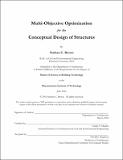Multi-objective optimization for the conceptual design of structures
Author(s)
Brown, Nathan C. (Nathan Collin)
DownloadFull printable version (17.19Mb)
Alternative title
MOO for the conceptual design of structures
Other Contributors
Massachusetts Institute of Technology. Department of Architecture.
Advisor
Caitlin T. Mueller.
Terms of use
Metadata
Show full item recordAbstract
Using computational tools, fast and accurate predictions of building performance are increasingly possible. In parallel, the expectations of a high-performance building have been rising in contemporary architecture, as designers must synthesize many inputs to arrive at a design that fulfills a wide range of requirements. Despite the clear need for assistance in prioritizing and managing different design objectives, advances in performance analysis have not commonly translated into guidance in early stage design, as the limits of the traditional design process and a separation of disciplines have relegated performance feedback to later phases. In order to facilitate better design on a holistic level, researchers in related areas have developed multiobjective optimization (MOO), which is a methodology intended for navigating complex design spaces while managing and prioritizing multiple objectives. However, after reviewing existing design optimization research and considering current usage of optimization in AEC practice, a number of clear research questions arise: How can conceptual, architectural design problems be formulated and solved using MOO in a way that generates diverse, high-performing solutions? What is the best way for the designers of buildings and structures to interact with MOO problems? Finally, how does the use of MOO in the conceptual phase affect design possibilities and outcomes? This thesis addresses these key research questions, along with a number of secondary questions, through a combination of design case studies, tool development, user experience testing, and historical analysis. First, it presents a conceptual framework for implementing MOO within architectural parametric design tools in flexible, interactive way. Next, it shows the outcomes of a conceptual design exercise in which participants are given increasing access to performance feedback. Finally, through the application of MOO to three long span roof case studies, it demonstrates how MOO can lead to diverse, high-performing results that are difficult to generate through other means, before introducing a new way in which multi-objective techniques can be used to analyze historical structures. Together, these contributions encourage more widespread and effective use of multi-objective optimization in conceptual design, leading to better performing buildings and structures without overly constraining creative, innovative designers. Key words: multi-objective optimization, design space exploration, conceptual design, design tradeoffs, interactive design tools, structural design, embodied and operational energy.
Description
Thesis: S.M. in Building Technology, Massachusetts Institute of Technology, Department of Architecture, 2016. This electronic version was submitted by the student author. The certified thesis is available in the Institute Archives and Special Collections. Cataloged from student-submitted PDF version of thesis. Includes bibliographical references (pages 107-113).
Date issued
2016Department
Massachusetts Institute of Technology. Department of ArchitecturePublisher
Massachusetts Institute of Technology
Keywords
Architecture.